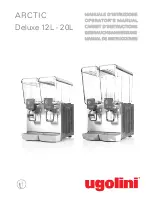
Figure
1
1
.
Top View Section-Cut of the Dispenser
STUB ROLL SUPPORTS
BATTERY
COVER
STUB-ROLL
MONITOR
TRANSFER
ARM
DC JACK
CONTROL
SWITCH
LED
LIGHT
Paper should be loaded with
the
paper “tail” unwinding from the back of
the roll. Place the
paper
"tail" under the Transfer Arm (Figure 11). Close
the cover and wait for the first LED flashing to indicate that the dispenser
is now ready for dispensing. Place a hand underneath the bottom center
of the dispenser to initiate the first dispense.
V
.
PAPER LOADING AND INITIATE THE FIRST DISPENSE
I
V
.
P
OWER-UP THE DISPENSER
For use with LoCor paper towels only (SKU numbers 46896,
46897, 46898, 46899, 46901 and 46902). Other types of paper are
not acceptable.
Power-up the Dispenser
Using Batteries
Recommend to use the
four
batteries
provided with the
dispenser
or
use
D-size alkaline batteries labeled with "LR20"
designation only.
O
pen the cover
using the key supplied in the hardware pack
.
Note that the battery compartment locating at the front of the
dispenser
(Figure 11)
.
Remove the
B
attery
C
over by pushing on
the tab inward and lifting up. Install four batteries into the
battery-compartment
with the orientation as showed on the
bottom of the compartment.
Close
the Battery Cover.
Power-up the Dispenser
Using a Power Converter Plug
Recommend to use the
power c
onverter
plug provided with the
dispenser only.
First, verify the dispenser does not have batteries installed.
Remove the dispenser from the mou
n
ting cabinet/wall if the
dispenser was mounted. Note the location of the DC Jack in in
the back of the dispenser (Figure 1
1
). Make sure there is an
access hole and enough space to safely route the wire into the
cabinet or into the wall. Plug the power converter into the DC
Jack. Install the dispenser.
Plug the converter into the outlet.
For warranty and safety purposes, it is required the power
converter must be plugged in an AC outlet that is not accessible
to the users. If not available, consult a licensed electrical
contractor. The power converter output is to be routed through
the mounting wall as a low voltage, energy limited circuit, similar
to a thermostat wire, with no requirement for electrical box or
attachment strain relief.
877
7
002
Released
February
22
201
9
9




























